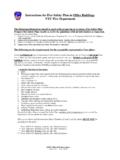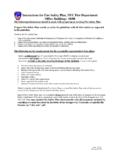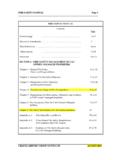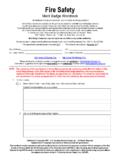Transcription of FIRE AND LIFE SAFETY - Shilpa Architects
1 fire AND life SAFETY -NAMRATA BHAGTANI 1101219-VANDANA VISHNU 1101234-SANGEETA 11012 Through the centuries there has been such an intimateconnection of fire with the cultural growth of we assume there was once a time when man hadno fire , but very early he must have become acquainted withfire derived from natural sources, and made use of it; for noremains of man's art show him without fire as hiscompanion. Much later in the scheme of things he inventedprocesses for making fire artificially. The early fires also formed a nucleus for human grouping, and became tribal or communal fires, from which the individual family fires derived. Worship or deification of fire is known from various religions. fire has been an important part of human culture since the Lower Paleolithic, as when people could not curtail fire easily, they started to revere it.
2 Fires -needed watching, not only to keep them from going out, but from spreading, or theft, so a fire -keeper was delegated to the work, thus starting a social organization. For as long as cities have existed, fires have been a problem. People have been concerned with an organized response to fire OF fire life SafetyThe primary goal of fire SAFETY efforts is to protect building occupants from injury and to prevent loss of life . Protection of PropertyThe secondary goal of fire SAFETY is to prevent property damage. Protection of OperationsBy preventing fires and limiting damage we can assure that work operations will continue. GOALS OF A fire PREVENTION PROGRAMA fire must have three things to ignite and maintain combustion: Fuel Heat OxygenThe basic strategy of fire prevention is to control or isolate sources of fuel and heat in order to prevent combustion.
3 If all three are not present in sufficient quantities a fire will not ignite or a fire will not be able to sustain OF fire PREVENTION The primary goal of fire SAFETY efforts is to protect building occupants from injury and to prevent loss of life and prevent property damage. According to Indian law, minimal fire SAFETY equipment is mandatory for any developed property. These laws are given by the National Building Code, which is a document containing standardized requirement for the design & construction of most types of building in the SAFETY AND REGULATIONS The National Building Code (NBC) is a national instrument that guides the regulations for construction activity. It contains all the important aspects relevant for safe and orderly building development.
4 The building that does not satisfy building code or violation of National building code will lead to penalty, cancellation of sanction or demolition of the GOVERNMENT OF ANDHRA PRADESH, MUNICIPAL ADMINISTRATION AND URBANDEVELOPMENT DEPARTMENT STATES IN THE HYDERABAD REVISED BUILDING RULES,2006 86 THAT ALL BUILDINGS SHALL BE PLANNED, DESIGNED ANDCONSTRUCTED TO ENSURE fire SAFETY REQUIREMENTS ARE MET AND MAINTAINEDAND SHALL COMPLY IN ACCORDANCE WITH THE fire PROTECTION REQUIREMENTS OFNATIONAL BUILDING CODE OF BUILDING SCHEMES SHALL BE CLEARED BYDIRECTOR OF fire SERVICE FOR SPECIAL BUILDINGS ABOVE 15M IN HEIGHT ANDABOVE 500 SAFETY IN HYDERABAD :-Residential Buildings - lodging or rooming houses, private dwellings, apartments, dormitories, Buildings - schools up to senior secondary level, all other schools, training institutesInstitutional Buildings -Hospitals and sanatoria, Custodial Institutions, Penal and Mental InstitutionsAssembly Buildings - mixed occupancy such as shopping, theatre, auditoriums, Buildings offices, banks, professional establishments, laboratories, libraries,test houses, computer institutions, telephone exchanges, broadcasting stations and TV OF BUILDINGS BASED ON OCCUPANCY.
5 -Mercantile Buildings- shops, stores, departments markets, underground shopping centres, storage and service Buildings low hazard, moderate hazard, high Buildings- Storage of Goods, wares and Buildings-Storage of Gases, Flammable Liquids, Liquefiable Gases, explosive materials, artificial flowers, synthetic leather, ammunition, explosives and fireworks. CLASSIFICATION OF BUILDINGS BASED ON OCCUPANCY:-Overlapping fire Zones: - When any building is situated in more than fire zone, it shall be deemed to be in the fire zone in which the major portion of the building or structure is situated. When the building is so situated that it exceeds equally to more than one fire zone, it shall be deemed to be in the fire zone having more hazardous OF BUILDINGS BASED ON fire ZONES:-Demarcations:- A city or area under the jurisdiction of the authority shall for the purpose of the Code, be demarcated into distinct zones, based on fire hazards inherent in the buildings and structures according to Occupancy that shall be called as fire Zones.
6 fire ZONESFire Zone 1:- Residential, educational, institutional, assembly, small business and retail mercantile Zone 2:- Business and Industrial Buildings except High Hazard Industrial Zone 3:- High Hazard Industrial Building, Storage Building and Buildings for Hazardous AND DEFINITIONS TERMS AND DEFINITIONS TERMS AND DEFINITIONS MINIMUM REQUIREMENTS FOR fire FIGHTING INSTALLATIONS ( NBC ):-MINIMUM REQUIREMENTS FOR fire FIGHTING INSTALLATIONS ( NBC ):-MINIMUM REQUIREMENTS FOR fire FIGHTING INSTALLATIONS ( NBC ):-MINIMUM REQUIREMENTS FOR fire FIGHTING INSTALLATIONS ( NBC ):-MINIMUM REQUIREMENTS FOR fire FIGHTING INSTALLATIONS ( NBC ):-MINIMUM REQUIREMENTS FOR fire FIGHTING INSTALLATIONS ( NBC ):-MINIMUM REQUIREMENTS FOR fire FIGHTING INSTALLATIONS ( NBC ):- fire PROTECTION AND MEANS OF EXIT REQUIREMENTS ( INCLUDING HIGH RISE BUILDINGS ):-1) General Exit Requirements :- may be a doorway, corridor, passageway to an internal or external staircase or to a verandah or roof which have access to the street or to the roof of the building or a refuge area.
7 May include horizontal exit leading to the adjoining building at same level. Shall be continuously maintained free of all obstructions or impediments in case of use in an emergency and shall provide continuous means of egress to exterior. 2) fire Access Stair Cases :- Buildings having an area of more than 500 per floor shall have a minimum of two staircases. 3) Doorways:- Shall open into an enclosed stairways or a horizontal exit of a corridor providing protected means of egress. Shall not be less than 1000mm in width, except in assembly buildings where it should not be less than 2000mm in width. Shall not be less than 2000mm in PROTECTION AND MEANS OF EXIT REQUIREMENTS ( INCLUDING HIGH RISE BUILDINGS ):-4) Corridors and Passageways:- Width shall not be less than the width of the exit doorways leading out from them.
8 Height shall not be less than 2400mm. Shall be adequately ) Internal Staircases:- Shall be composed of non-combustible materials throughout. External wall of building shall constitute one of its sides. Shall not be arranged around a lift shaft. Minimum flight width=1000mm, Maximum flight width=2000mm. Minimum tread = 250mm, Maximum riser=190mm, Minimum Head Room=2200mm.( varying slightly based on classification of buildings).6) External Staircases:- An external staircase is desirable to be provided for high rise buildings. Shall be kept in sound operable condition. Shall be directly connected to the ground. Entrance shall be separate and remote from the internal staircase. No wall opening or window opens on to or close to the external stairs. Route to the external stairs shall be free of obstruction at all times.
9 Shall be constructed of non-combustible materials and any doorway leading to it shall have the required fire resistance. Shall have straight flight not less than 1250mm wide with 250mm treads and risers not more than 190mm. The number of risers shall be restricted to 15 per flight. Handrails shall be of a height not less than 1000mm and not exceeding 1200mm. Provision of balusters with maximum gap of PROTECTION AND MEANS OF EXIT REQUIREMENTS ( INCLUDING HIGH RISE BUILDINGS ):- The use of spiral staircase shall not be less than 1500mm in diameter and shall be designed to give adequate headroom. Unprotected steel frame will not be accepted as a means of escape. However steel staircase in an enclosed fire rated compartment of 2h will be accepted as a means of ) Horizontal Exits:- The width of horizontal exit shall be same as that for the exit doorways.
10 A horizontal exit shall be equipped with at least one fire / smoke door of minimum 1h fire resistance, of self closing type. Where there is a difference in level between connected areas for horizontal exits, ramps not more than 1 in 10 slope shall be provided, steps shall not be used. Doors in horizontal exits shall be operable at all times from both PROTECTION AND MEANS OF EXIT REQUIREMENTS ( INCLUDING HIGH RISE BUILDINGS ):-8) Refuge Areas:- Shall be provided on the periphery of the floor or preferably on a cantilever projection and open to air at least on one side protected with suitable railing. For floors above 24 m and up to 39m- one refuge area on the floor immediately above 24m. For floors above 39m one refuge area on the floor immediately above 39 m and so on after every 15m.





